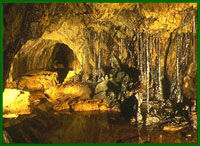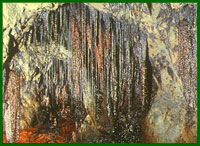 |
|
|||
|
Sygun
Copper
|
Geology and Mineralisation Underground, it is possible to see the slot-like excavations blasted out of the rock, where the lodes contained sufficient copper-ore to be worth taking were mined away. Such slot-like excavations are called stopes. Snowdon and its surroundings formed an important mining district in the 18th and 19th centuries. The mineral lodes are common and were worked predominantly for copper but also locally for lead and, in the Bethesda area, for arsenic. The mines were generally moderate in size, and their mountain setting made the carrying on of the works difficult, especially on Snowdon itself where there are mines nearly 2000 feet (610m) above sea level. It is a sobering experience to walk up to Llwyndu on a wet and windy autumn afternoon and just try to imagine having to work there every day, regardless of weather and without modern waterproofs! The Snowdonia copper-miners must have been a tough bunch.
Volcanic activity continued beyond this point in time, but was never quite so intense, and eventually the area returned to the quiet marine conditions it had known previously. But members of a British Geological Survey mapping team in 1985 only recently worked out exactly when the copper-lodes were formed. During the waning stages of the volcanic activity, convection took place of seawater, which had found its way into the roots of the volcano. These hot (hydrothermal) fluids were convected due to the heat from the molten magma, and were forced through the massive pile of erupted rocks. Because they were hot brines, they were easily able to dissolve copper and other metals from the volcanic lavas and ashes. In time, they found their way into the fault system that had controlled how the volcano had developed in the first place. Here, they deposited the copper-ores and other minerals, at a depth below surface estimated to be around 2 kilometres. Two sulphides dominate the minerals occurring at Sygun. Pyrite, iron sulphide, is very common, but was thrown away as waste. It is a bright yellowish-white colour and is both hard and heavy. Chalcopyrite, the ore of copper, is a copper-iron sulphide. It is also yellow, but is a much richer golden colour. It is heavy like pyrite but softer, and often develops a colourful tarnish due to weathering. Accompanying the copper-ores at Sygun are waste or gangue (pronounced "gang") minerals. These comprise quartz, which is hard, splintery and milky-white in colour. With the quartz a dull green, finely flaky mineral often occurs. This is chlorite, a complex silicate mineral containing iron and magnesium among other elements. More recently, in geological terms, weathering has altered some of the lodes close to the surface. By the footpath to Llwyndu, near the top of the hill, piles of pink and yellow bleached tuff mark some small test-workings for iron-ores. These were formed by deep leaching of the tuffs along fault-lines, just leaving behind the bleached rocks and pods of iron oxides. A similar process occurs today, underground in Sygun mine. Waters percolating down through the rocks pick up iron and, where they drip through the mine roof, deposit it as long brown stalactites. Where copper-ores are close to hand, these stalactites may be of copper sulphate and are then a beautiful blue colour.
|

 The
copper-ores worked at Sygun - and indeed the rocks which form the hillside
- owe their existence to a set of geological circumstances which came
together during the Ordovician Period, over 460 million years ago. At
this time, a great volcano emerged from the seas which covered most of
North Wales back then. The Snowdon Volcanic Group, which forms most of
this area, consists of the lavas and ashes erupted during the lifecycle
of the volcano. At the base of the volcanic rocks, there are lava-flows
whose appearance is indicative of submarine eruption. This early activity
was followed by a massive eruption that deposited the rocks at Sygun,
which are known as the Lower Rhyolitic Tuff Formation. The eruption produced
an incredible 60km3 (estimated) of rocks called ash-flow tuffs, which
are formed when incandescent clouds of ash explode from a volcano and
roll rapidly down its slopes. Similar eruptions have occurred in recent
times, such as at Mount St Helens, in 1980, and more recently, at Montserrat.
But these were both small incidents compared to the events that occurred
around Snowdon back in the Ordovician Period!
The
copper-ores worked at Sygun - and indeed the rocks which form the hillside
- owe their existence to a set of geological circumstances which came
together during the Ordovician Period, over 460 million years ago. At
this time, a great volcano emerged from the seas which covered most of
North Wales back then. The Snowdon Volcanic Group, which forms most of
this area, consists of the lavas and ashes erupted during the lifecycle
of the volcano. At the base of the volcanic rocks, there are lava-flows
whose appearance is indicative of submarine eruption. This early activity
was followed by a massive eruption that deposited the rocks at Sygun,
which are known as the Lower Rhyolitic Tuff Formation. The eruption produced
an incredible 60km3 (estimated) of rocks called ash-flow tuffs, which
are formed when incandescent clouds of ash explode from a volcano and
roll rapidly down its slopes. Similar eruptions have occurred in recent
times, such as at Mount St Helens, in 1980, and more recently, at Montserrat.
But these were both small incidents compared to the events that occurred
around Snowdon back in the Ordovician Period!  In
the Snowdon area, a large number of other ore-minerals have been recorded.
They include the lead and zinc sulphides galena and sphalerite - the chief
ores worked at Llywernog but not occurring in enough quantity up here.
Arsenopyrite or mispickel is a sulphide of iron and arsenic, silvery-white
in colour, which is quite common in places. Pyrrhotite (pronounced "pirotite"),
a magnetic sulphide of iron, likewise occurs commonly in some areas.And
on the opposite side of the Nant Gwynant, at the Braichyroen mine, work
by the National Museums and Galleries of Wales has resulted in the discovery
of the rare lead-bismuth mineral cosalite.
In
the Snowdon area, a large number of other ore-minerals have been recorded.
They include the lead and zinc sulphides galena and sphalerite - the chief
ores worked at Llywernog but not occurring in enough quantity up here.
Arsenopyrite or mispickel is a sulphide of iron and arsenic, silvery-white
in colour, which is quite common in places. Pyrrhotite (pronounced "pirotite"),
a magnetic sulphide of iron, likewise occurs commonly in some areas.And
on the opposite side of the Nant Gwynant, at the Braichyroen mine, work
by the National Museums and Galleries of Wales has resulted in the discovery
of the rare lead-bismuth mineral cosalite.